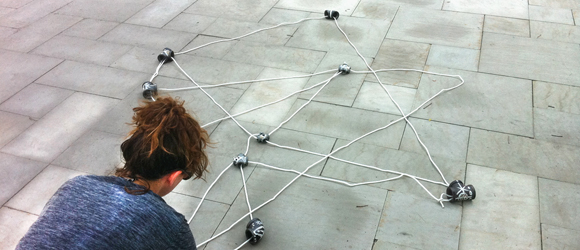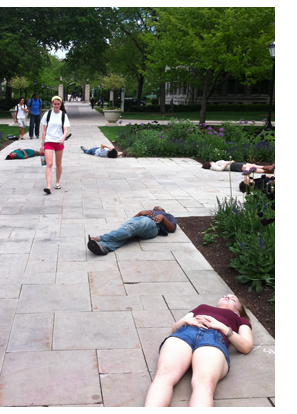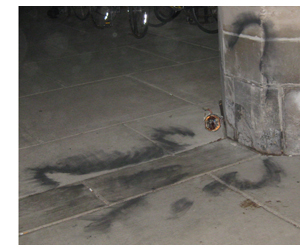| Sun | Mon | Tue | Wed | Thu | Fri | Sat |
|---|---|---|---|---|---|---|
| 1 | 2 | 3 | 4 | 5 | ||
| 6 | 7 | 8 | 9 | 10 | 11 | 12 |
| 13 | 14 | 15 | 16 | 17 | 18 | 19 |
| 20 | 21 | 22 | 23 | 24 | 25 | 26 |
| 27 | 28 | 29 | 30 | 31 |
CATEGORIES
RECENT ENTRIES
BLOG ROLL
Down the rabbit hole
A look back at UChicago's first transmedia game.
By Mitchell Kohles, '12

If you happened to visit campus last spring, you probably noticed some bizarre ephemera scattered across campus: strange metallic lattices, rotationally symmetric veves (pictured below right), or a group of motionless bodies splayed out on the sidewalk in the center of the quad. Unless you were among the few to stubble upon a rabbit hole into this strange world, most of it probably went over your head.
 Oscillation, the University of Chicago’s first Alternate Reality Game (ARG), came and went without attracting too much attention. But you had to be holed up deep within the Reg not to notice the ways in which the game’s designers and players transformed campus in the last five weeks of spring quarter. Oscillation belongs to a new genre of interactive fiction in which players interact with various media—in this case, paper flyers, tape cassettes, websites, IRC chats, text-based adventure games, and even sidewalk chalk—to connect with each other and engage with the world around them in to create a unique narrative experience. Often these ARGs are used by production companies to promote more mainstream video games or movies, but Oscillation was a stand-alone project designed by students and faculty and sponsored by the UnCommon Fund.
Oscillation, the University of Chicago’s first Alternate Reality Game (ARG), came and went without attracting too much attention. But you had to be holed up deep within the Reg not to notice the ways in which the game’s designers and players transformed campus in the last five weeks of spring quarter. Oscillation belongs to a new genre of interactive fiction in which players interact with various media—in this case, paper flyers, tape cassettes, websites, IRC chats, text-based adventure games, and even sidewalk chalk—to connect with each other and engage with the world around them in to create a unique narrative experience. Often these ARGs are used by production companies to promote more mainstream video games or movies, but Oscillation was a stand-alone project designed by students and faculty and sponsored by the UnCommon Fund.
The game centered on a fictional narrative about a group of scientists from a parallel universe who needed help from our own—players searched for clues and solved puzzles, both online and on campus, to ensure a balance between the two worlds. A few of the head designers and players got together in Walker Museum in July to reminisce about their experiences.
At the table:
- Moira Cassidy, AB’11, game design writer
- Patrick Jagoda, game design director, assistant professor of English
- Patrick McWilliams, AB’10, player
- Russell Ruch, AB’09, player
- Ainsley Sutherland, AB’11, game design director

What was it like playing the game?
Ruch: I remember one night Janice [another player] and I were at the MacLab until midnight just trying to solve this stupid puzzle. And there’s no reason that you have to do it, because it’s a game, but maybe the fact that it is an ARG and it’s not something where you can just put the console away and walk away from — it makes you want to do it more.
McWilliams: The stakes somehow seem higher because it’s not so clear that it is a game. It feels like it requires your participation almost.
Ruch: After completing a puzzle, we were able to find a box of electronic parts that we were supposed to solder together to build a lattice of lights, and it turned out I was the only person that knew how to solder. And I’m not a really good solderer, so that failed. But they adapted the story around it, so that turned out okay.
Jagoda: We actually kept open the possibility that you would fail, so we had that story ready.
Cassidy: Originally, there were several permutations of boxes and lights, so depending on which box you did, or if you did them together, the light patterns displayed would be different. Narrative-wise, you were supposed to figure out that one of the people giving you instructions would lead you to your doom. We were very Master-of-Puppets sometimes [laughs].
You never officially announced that there was an ARG happening on campus. How did the players treat the game during those five weeks?
Jagoda: There is this breakdown between game play and real life that happens in almost all of these games, and you start seeing things, and you’re not sure if they’re part of the game or they’re just part of the life of the campus. It produces this sort of paranoia.
McWilliams: I thought that was the appeal, the idea of being able to construct your own idea of what the game is. What is and what isn’t. It becomes a way to sort out the world around you and make it into some sort of parallel universe. You can only sort of half-see everything, and you have to use what you do see to fill in the rest.

What were some of the challenges of creating an ARG from scratch?
Sutherland: One of the challenges, with a game like ours, is that we didn’t have a product behind it. The players couldn’t say, “Oh, this is like Halo, so…” or, “Oh, I know what this word means.”
Jagoda: Virtually every other ARG has some advertising component and requires a type of funding that takes away from the experience, so actually one of the advantages of doing this at a University is that you don’t have to compromise your artistic vision.
Sutherland: A lot of the planning happened during the game too. Things went wrong, or things were discovered in the wrong order [by the players] and we had to reevaluate.
Cassidy: Or they cracked our puzzles in ways we didn’t think were possible. They looked at our source code to get the passwords. But once we found out they were doing it, we created a whole puzzle around using the source code to sort of respond to that.
Jagoda: It’s really a live design process, because you have to adapt on the spot. It’s not like making a movie or writing a novel where you already know what the form is and you have thousands of examples from which to draw. You’re making a new thing every single time—the form of transmedia games is only about a decade old.
What was the reaction on campus?
Sutherland: Having people be like, “Oh, I’m so excited about this,” was such a big thing. Because we thought people were going to hate it.
Jagoda: I still think the first rabbit hole [the event depicted in the trailer] was still totally atmospheric and cool. It was a puzzle, but luring them in in this particular way, even though that many people didn’t show up, made it so there was still a description of this going around. I think we got that moment so right.
Sutherland: There were obviously people who knew us and knew that we were involved, but weren’t playing the game, and so we would get accused of things that were happening on campus. People would say things like, “I saw this happening, was this your fault?” We did have a police report filed on us.
Ruch: Really?
Sutherland: Well, we did this preview for the game where we drew chalk bodies on the ground and had weird little machines lying around, and somebody reported it to the police.
August 25, 2011
